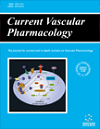- Home
- A-Z Publications
- Current Vascular Pharmacology
- Previous Issues
- Volume 7, Issue 1, 2009
Current Vascular Pharmacology - Volume 7, Issue 1, 2009
Volume 7, Issue 1, 2009
-
-
Purines as Neurotransmitters and Neuromodulators in Blood Vessels
More LessBy Vera RalevicATP is an important neurotransmitter being released with noradrenaline (NA) and neuropeptide Y (NPY) from perivascular sympathetic nerves; it acts at postjunctional P2X receptors to evoke vascular smooth muscle contraction, often synergising with the effects of NA acting at α-adrenoceptors. There is growing evidence for ATP as a neurotransmitter in perivascular non-adrenergic non-cholinergic nerves. In additi Read More
-
-
-
Cannabinoid Modulation of Perivascular Sympathetic and Sensory Neurotransmission
More LessAuthors: Vera Ralevic and David A. KendallCannabinoids are signalling molecules which elicit their vascular effects mainly via G protein-coupled CB1 receptors and transient receptor potential (TRP) channels (chiefly vanilloid TRPV1 receptors). Cannabinoids can act at prejunctional CB1 receptors to inhibit perivascular sympathetic neurotransmission. The effects of cannabinoids on perivascular capsaicin-sensitive sensory nerves are more complex. Certain cannabin Read More
-
-
-
Cerebrovascular Endothelin Receptor Upregulation in Cerebral Ischemia
More LessStroke is a serious neurological disease and the third leading cause of death in the western world. In roughly 15 % of the cases, the cause is due to an intracranial haemorrhage, and the remaining 85 % represent ischemic strokes. Ischemic stroke is caused by the occlusion of a cerebral artery either by an embolus or by local thrombosis. Several studies have shown an involvement of the endothelin system in ischemic stroke. Th Read More
-
-
-
Neuronal Regulators and Vascular Dysfunction in Raynaud's Phenomenon and Systemic Sclerosis
More LessAuthors: Carmen Fonseca, David Abraham and Markella PonticosRaynaud's phenomenon (RP) results from an exaggerated cutaneous vasospastic response to cold or emotional stress. The mechanisms that lead to impaired cutaneous vascular tone are complex. The regulation of cutaneous vasoconstriction and vasodilation, involves altered sympathetic nerve activity and a host of neuronal regulators, including adrenergic and non-adrenergic, as well as REDOX signalling and other signalli Read More
-
-
-
Neuronal Regulation of Aortic Valve Cusps
More LessAuthors: Ismail El-Hamamsy, Magdi H. Yacoub and Adrian H. ChesterHeart valves have long been considered exclusively passive structures that open and close in response to changes in transvalvular pressure during the cardiac cycle. Although this is partly true, recent evidence suggests that valves are far more sophisticated structures. Microscopic examination of heart valves reveals a complex network of endothelial cells, interstitial cells, an extracellular matrix and a rich network of intrinsic ner Read More
-
-
-
The Saphenous Vein as a Bypass Conduit: The Potential Role of Vascular Nerves in Graft Performance
More LessAuthors: Michael R. Dashwood and Andrzej LoeschThe saphenous vein is the most commonly used conduit in patients undergoing coronary artery bypass surgery. However, a high proportion of vein grafts occlude within the first year and over 50% patients require further grafting within 10 years. Using conventional harvesting techniques the saphenous vein is damaged due to considerable surgical and mechanical trauma, a situation that affects graft patency. As a superficial v Read More
-
-
-
On the Sympathetic Innervation of the Human Greater Saphenous Vein: Relevance to Clinical Practice
More LessAuthors: Andrzej Loesch and Michael R. DashwoodThis review focuses on sympathetic perivascular innervation of human saphenous vein. It shows the distribution of the nerves in the vein wall, including an association of the nerves with the vasa vasorum system. An account of a possible contribution of sympathetic nerves to the physiology of the saphenous vein, as well as their relevance to the outcome of coronary artery bypass surgery that uses the vein as a graft, is discussed.
-
-
-
Postprandial Glucose - A Potential Therapeutic Target to Reduce Cardiovascular Mortality
More LessAuthors: Raj Peter, Onyebuchi E. Okoseime, Alan Rees and David R. OwensCardiovascular disease (CVD) accounts for almost 75% of mortality in subjects with type 2 diabetes (T2DM). The relationship between hypertension, dyslipidaemia and CVD is now well established. However, the precise link between glycaemia and macrovascular complications has remained unclear. There is now emerging evidence that postprandial glucose (PPG) contributes significantly to CVD risk, although to date there ar Read More
-
-
-
Models to Study Atherosclerosis: A Mechanistic Insight
More LessAuthors: Vishal Singh, Rajiv L. Tiwari, Madhu Dikshit and Manoj K. BarthwalThe recent failure of candidate drugs like cholesterol ester transfer protein (CETP) and acyl-CoA:cholesterol acyltransferase (ACAT) inhibitors calls for a revised approach for screening anti-atherosclerotic drugs and development of new models of atherosclerosis. For this it is important to understand the mechanism of the disease in a particular model. Models simultaneously showing hyperlipidemia, inflammation and assoc Read More
-
Volumes & issues
-
Volume 23 (2025)
-
Volume 22 (2024)
-
Volume 21 (2023)
-
Volume 20 (2022)
-
Volume 19 (2021)
-
Volume 18 (2020)
-
Volume 17 (2019)
-
Volume 16 (2018)
-
Volume 15 (2017)
-
Volume 14 (2016)
-
Volume 13 (2015)
-
Volume 12 (2014)
-
Volume 11 (2013)
-
Volume 10 (2012)
-
Volume 9 (2011)
-
Volume 8 (2010)
-
Volume 7 (2009)
-
Volume 6 (2008)
-
Volume 5 (2007)
-
Volume 4 (2006)
-
Volume 3 (2005)
-
Volume 2 (2004)
-
Volume 1 (2003)
Most Read This Month
Article
content/journals/cvp
Journal
10
5
false
en


